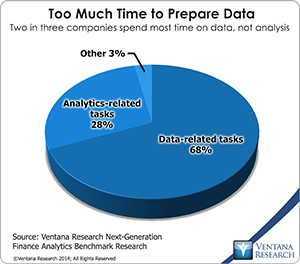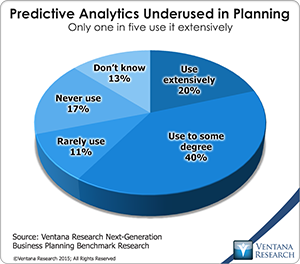IBM’s Vision user conference brings together customers who use its software for financial and sales performance management (FPM and SPM, respectively) as well as governance, risk management and compliance (GRC). Analytics is a technology that can enhance each of these activities. The recent conference and many of its sessions highlighted IBM’s growing emphasis on making more sophisticated analytics easier to use by – and therefore more useful to – general business users and their organizations. The shift is important because the IT industry has spent a quarter of a century trying to make enterprise reporting (that is, descriptive analytics) suitable for an average individual to use with limited training. Today the market for reporting, dashboards and performance management software is saturated and largely a commodity, so the software industry – and IBM in particular – is turning its attention to the next frontier: predictive and prescriptive analytics. Prescriptive analytics holds particular promise for IBM’s analytics portfolio.
The three basic types of analytics – descriptive, predictive and  prescriptive – often are portrayed as a hierarchy, with descriptive analytics at the bottom and predictive and prescriptive (often referred to as “advanced analytics”) on the next two rungs. Descriptive analytics is like a rear-view mirror on an organization’s performance. This category includes variance and ratio analyses, dashboards and scorecards, among others. Continual refinement has enabled the software industry to largely succeed in making descriptive analytics an easy-to-use mainstream product (even though desktop spreadsheets remain the tool of choice). Today, companies in general and finance departments in particular handle basic analyses well, although they are not as effective as they could be. Our research on next-generation finance analytics shows, for example, that most financial analysts (68%) spend the largest amount of their time in the data preparation phases while a relatively small percentage (28%) use the bulk of their time to do what they are supposed to be doing: analysis. We find that this problem is mainly the result of issues with data, process and training.
prescriptive – often are portrayed as a hierarchy, with descriptive analytics at the bottom and predictive and prescriptive (often referred to as “advanced analytics”) on the next two rungs. Descriptive analytics is like a rear-view mirror on an organization’s performance. This category includes variance and ratio analyses, dashboards and scorecards, among others. Continual refinement has enabled the software industry to largely succeed in making descriptive analytics an easy-to-use mainstream product (even though desktop spreadsheets remain the tool of choice). Today, companies in general and finance departments in particular handle basic analyses well, although they are not as effective as they could be. Our research on next-generation finance analytics shows, for example, that most financial analysts (68%) spend the largest amount of their time in the data preparation phases while a relatively small percentage (28%) use the bulk of their time to do what they are supposed to be doing: analysis. We find that this problem is mainly the result of issues with data, process and training.
The upward shift in focus to the next levels of business analytics was a common theme throughout the Vision conference. This emphasis reflects a key element of IBM’s product strategy: to achieve a competitive advantage by making it easy for most individuals to use advanced analytics with limited training and without an advanced degree in statistics or a related discipline.
The objective in using predictive analytics is to improve an organization’s ability to determine what’s likely to happen under certain circumstances with greater accuracy. It is used for four main functions:
- Forecasting - enabling more nuanced projections by using multiple factors (such as weather and movable holidays for retail sales)
- Alerting - when results differ materially from forecast values
- Simulation – understanding the range of possible outcomes
 under different circumstances
under different circumstances
- Modeling – understanding the range of impacts of a single factor.
Our research on next-generation business planning finds that despite its potential to improve the business value of planning, only one in five companies use predictive analytics extensively in their planning processes.
Predictive analytics can be useful for every facet of a business and especially for finance, sales and risk management. It can help these functions achieve greater accuracy in sales or operational plans, financial budgets and forecasts. The process of using it can identify the most important drivers of outcomes from historical data, which can support more effective modeling. Because plans and forecasts are rarely 100 percent accurate, a predictive model can support timely alerts when outcomes are significantly different from what was projected, enabling organizations to better understand the reasons for a disparity and to react to issues or opportunities sooner. When used for simulations, predictive models can give executives and managers deeper understanding of the range of potential outcomes and their most important drivers.
Prescriptive analytics, the highest level, help guide decision-makers to make the best choice to achieve strategic or tactical objectives under a specified set of circumstances. The term is most widely applied to two areas:
- Optimization – determining the best choice by taking into account the often conflicting business objectives or other forms of trade-offs while factoring in business constraints - for example, determining the best price to offer customers based on their characteristics. This helps businesses achieve the best balance of potential revenue and profitability or farmers to find the least costly mix of animal feeds to achieve weight objectives.
- Stochastic Optimization – determining the best option as above but with random variables such as a commodity price, an interest rate or sales uplift. Financial institutions often use this form of prescriptive analytics to understand how to structure fixed income portfolios to achieve an optimal trade-off between return and risk.
General purpose software packages for predictive and prescriptive analytics have existed for decades, but they were designed for expert users, not the trained rank-and-file. However, some applications that employ optimization for a specific purpose have been developed for nonexpert business users. For example, price and revenue optimization software, which I have written about is used in multiple industries. Over the past few years, IBM has been making progress in improving ease of use of general purpose predictive and prescriptive analytics. These improvements were on display at Vision. One of the company’s major initiatives in this area is Watson Analytics. It is designed to simplify the process of gathering a set of data, exploring it for meaning and importance and generating graphics and storyboards to convey the discoveries. Along the way, the system can evaluate the overall suitability of the data the user has assembled for creating useful analyses and assisting general business users in exploring its meaning. IBM offers a free version that individuals can use on relatively small data sets as a test drive. Watson is a cognitive analytics system, which means it is by nature a work in progress. Through experience and feedback it learns various things including terminologies, analytical methods and the nuances of data structures. As such it will become more powerful as more people use it for a wider range of uses because of the system’s ability to “learn” rather than rely on a specific set of rules and logic.
Broader use of optimization is the next frontier for business software vendors. Created and used appropriately, optimization models can deliver deep insights into the best available options and strategies more easily, accurately, consistently and effectively than conventional alternatives. Optimization eliminates individual biases, flawed conventional wisdom and the need to run ongoing iterations to arrive at the seemingly best solution. Optimization is at the heart of a network management and price and revenue optimization, to name two common application categories. Dozens of optimization applications (including ILOG, which IBM acquired) are available, but they are aimed at expert users.
IBM’s objective is to make such prescriptive analytics useful to a wider audience. It plans to infuse optimization capabilities it into all of its analytical applications. Optimization can be used on a scale from large to small. Large-scale optimization supports strategic breakthroughs or major shifts in business models. Yet there also are many more ways that the use of optimization techniques embedded in a business application – micro-optimization – can be applied to business. In sales, for example, it can be applied to territory assignments taking into account multiple factors. In addition to making a fair distribution of total revenue potential, it can factor in other characteristics such as the size or profitability of the accounts, a maximum or minimum number of buying units and travel requirements for the sales representative. For operations, optimization can juggle maintenance downtime schedules. It can be applied to long-range planning to allocate R&D investments or capital outlays. In strategic finance it can be used to determine an optimal capital structure where future interest rates, tax rates and the cost of equity capital are uncertain.
Along the way IBM also is trying to make optimization more accessible to expert users. Not every company or department needs or can afford a full suite of software and hardware to create applications that employ optimization. For them, IBM recently announced Decision Optimization on Cloud (DOcloud), which provides this capability as a cloud-based service; it also broadens the usability of IBM ILOG CPLEX Optimizer. This service can be especially useful to operations research professionals and other expert users. Developers can create custom applications that embed optimization to prescribe the best solution without having to install any software. They can use it to create and compare multiple plans and understand the impacts of various trade-offs between plans. The DOcloud service also provides data analysis and visualization, scenario management and collaborative planning capabilities. One example given by IBM is a hospital that uses it to manage its operating room (OR) scheduling. ORs are capital-intensive facilities with high opportunity costs; that is, they handle procedures that utilize specific individuals and different combinations of classes of specialists. Procedures also have different degrees of time flexibility. Without using an optimization engine to take account of all the variables and constraints, crafting a schedule is time-consuming. And since “optimal” solutions to business problems are fleeting, an embedded optimization engine enables an organization to replan and reschedule quickly to speed up decision cycles.
Businesses are on the threshold of a new era in their use of analytics for planning and decision support. However, numerous barriers still exist that will slow widespread adoption of more effective business practices that take full advantage of the potential that technology offers. Data issues and a lack of awareness of the potential to use more advanced analytics are two important ones. Companies that want to lead in the use of advanced analytics need leadership that focuses on exploiting technology to achieve a competitive advantage.
Regards,
Robert Kugel – SVP Research











